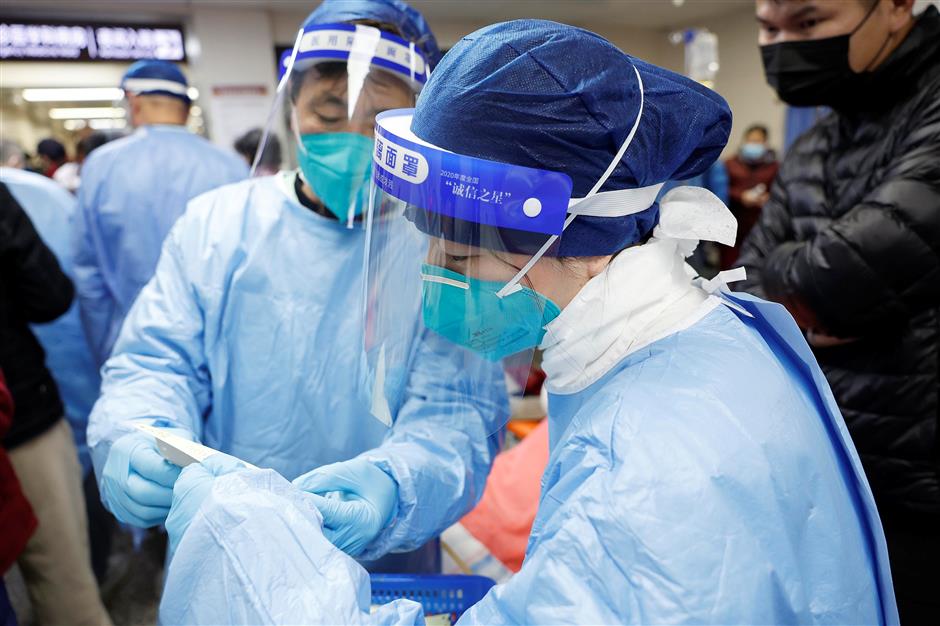Medical institutions coping with challenges

Shanghai is mobilizing medical institutions at all levels to serve patients.
The current wave of COVID infection in Shanghai may have entered its peak period on December 22, the city's top infectious disease expert has said.
It is estimated around 10 million residents have contracted the SARS-CoV-2 virus, and with an estimated hospitalization rate of 0.5 percent, local hospitals have needed to take in some 50,000 patients in recent weeks, said Zhang Wenhong.
Zhang is an adviser to authorities in Shanghai on treatment for COVID-19 and head of the center of infectious diseases at Huashan Hospital of Fudan University.
"Although the proportion of critical patients is low, the absolute number is large, and medical institutions are coping with the challenges by all means," he said.
Zhang told an interview with People's Daily earlier this week that medical institutions at all levels are making all-out efforts to treat patients with severe symptoms.
Emergency patients more than doubled in recent days, according to Chen Erzhen, vice president of Shanghai's Ruijin Hospital.
The city is set to encounter the peak of critical cases, and the capacity for diagnosis and treatment at the community medical institutions and their medicine reserves are gradually improving, he noted.
The number of visits paid to the emergency department of the hospital has reached 1,500 per day, while visits paid to the hospital's fever clinic are down from 600 visits per day to 300 visits per day.
COVID-19 patients account for 80 percent of the emergency patients and elderly patients account for 40 percent to 50 percent of the COVID-19 patients. More than half of the patients aged 65 years or above have pneumonia.
He also called for less vulnerable groups, those with no underlying diseases and only mild symptoms of fever, sore muscles and cough and no obvious short breath to choose district-level hospitals and community medical institutions for treatment.
How are medical institutions dealing with the challenges?
Zhang Wenhong: Shanghai is mobilizing all levels of medical institutions from primary care clinics to tertiary hospitals to save critically ill patients.
It's essential to treat patients within the most critical 72 hours.
Neighbourhood medical institutions are increasing the number of fever clinics, enhancing the training of medical personnel, providing oxygen therapy and antiviral drugs, and formulating standardized treatment manuals.
They're also ensuring critically ill patients can be referred to higher-level hospitals through the triage protocol as soon as possible.
Secondary and tertiary hospitals are optimizing patient admission process and have made more ward beds available to make sure most critical patients are admitted within 24 hours.
You tested positive for COVID, how were your symptoms?
Zhang: I had very mild symptoms. I stayed at home and attended virtual meetings on the first day. I returned to the hospital and visited COVID patients' wards on the second day.
I have been working in the wards ever since then and my colleagues didn't notice I had been tested positive. I had taken four vaccine shots and I recommend people to get vaccinated as soon as possible.

City's top infectious disease expert Zhang Wenhong is interviewed by the People's Daily online.
What are the treatment methods, and are there any new medications for patients?
Zhang: Vaccinations have proved to effectively lower the number of deaths and critically ill patients.
We have also made some preparations in terms of antiviral drugs, respiratory support, ICU ward and equipment.
We use oxygen therapy early to correct hypoxia and hormones to treat inflammation and anticoagulation in the early stage of cardiovascular symptoms.
We must strive forward and dedicate our utmost efforts to save critical patients with both early diagnosis and treatment at the primary care clinics as well as at ICU wards.
What special measures have been taken for the elderly and vulnerable group?
Zhang: About 88,000 elderly people in Shanghai live in nursing homes, 22,000 people are staying in elderly-care institutions, and 700,000 to 800,000 senior citizens with various underlying diseases are at home.
More than five million of the population are aged above 60 years.
We have implemented closed management for nursing homes and advised the elderly to stay at home and go out less, avoid crowded spaces and gathering to avoid the peak of infections.
However, due to the rapid spread of Omicron, the infection rate of the elderly is still relatively high, and the number of seriously ill patients is increasing.
Shanghai is now entering a critical period and we're striving to bring medical resources to the elderly so that the vulnerable can be treated within the "golden 72 hours".
District-level authorities are organizing medical treatments and resources to reach nursing facilities and homes for the elderly. City-level experts are also working with the grassroots facilities in different regions to strengthen diagnosis, consultation and training.
Shanghai needs to effectively mobilize all levels from the grassroots to the core center, and each family also needs to know how to keep vulnerable groups safe and when should they seek medical care under critical conditions.
Every community health care center is also expanding their treatment capability as much as possible.
Nutrition is fundamental to the treatment of COVID-19 infection. The importance of nutrition cannot be overemphasized. All infected people or elderly people under home observation must pay special attention to increasing nutrition, including diversified and balanced intake of vegetables and carbohydrates. High-quality protein intake is the top priority.

















